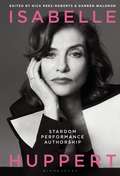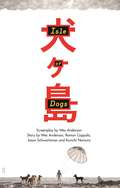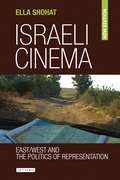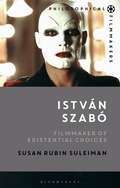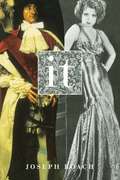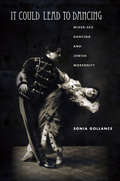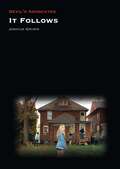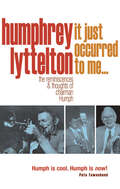- Table View
- List View
Isabelle Huppert: Stardom, Performance, Authorship
Featuring a lineup of distinguished academics, this collection remedies the absence of scholarly attention on French cinematic legend Isabelle Huppert. This volume deconstructs Huppert's star persona and public profile through critical and theoretical analysis of her various screen roles-from her very early appearances alongside Romy Schneider in César et Rosalie (Sautet, 1972) and Gérard Depardieu in Les Valseuses (1974) to a number of celebrated collaborations with high-profile European auteurs such as Catherine Breillat, Claire Denis, Jean-Luc Godard, Michael Haneke and Joseph Losey, and with more popular auteurs such as Claude Chabrol and François Ozon. Known for a cerebral internalization of characterization, a technical mastery of extreme emotions, and a singular brand of icy intellectualism, Huppert's performances continue to impress, stun and surprise audiences. By focusing on several theoretical questions that relate to image, identity, sexuality and place, this volume situates Huppert's star persona in the more practical creative contexts of performance, authorship, genre and collaboration. This volume contrasts complementary critical accounts of her stardom by working across the different periods and territories of her career.
Ishiro Honda: A Life in Film, from Godzilla to Kurosawa
by Steve Ryfle Ed GodziszewskiIshiro Honda was arguably the most internationally successful Japanese director of his generation, with an unmatched succession of science fiction films that were commercial hits worldwide. From the atomic allegory of Godzilla and the beguiling charms of Mothra to the tragic mystery of Matango and the disaster and spectacle of Rodan, The Mysterians, King Kong vs. Godzilla, and many others, Honda's films reflected postwar Japan's real-life anxieties and incorporated fantastical special effects, a formula that appealed to audiences around the globe and created a popular culture phenomenon that spans generations. Now, in the first full account of this long overlooked director's life and career, authors Steve Ryfle and Ed Godziszewski shed new light on Honda's work and the experiences that shaped it—including his days as a reluctant Japanese soldier, witnessing the aftermath of Hiroshima, and his lifelong friendship with Akira Kurosawa. Ishiro Honda: A Life in Film, from Godzilla to Kurosawa features close analysis of Honda's films (including, for the first time, his rarely seen dramas, comedies, and war films) and draws on previously untapped documents and interviews to explore how creative, economic, and industrial factors impacted his career. Fans of Honda, Godzilla, and tokusatsu (special effects) film, and of Japanese film in general, will welcome this in-depth study of a highly influential director who occupies a uniquely important position in science fiction and fantasy cinema, as well as in world cinema. Together, the authors have provided audio commentary tracks and produced supplemental material for numerous home video releases, including Ishiro Honda's Godzilla for the British Film Institute. They co-produced the documentary feature Bringing Godzilla Down to Size (2008).
Ishtyle: Accenting Gay Indian Nightlife (Triangulations: Lesbian/Gay/Queer Theater/Drama/Performance)
by Kareem KhubchandaniIshtyle follows queer South Asian men across borders into gay neighborhoods, nightclubs, bars, and house parties in Bangalore and Chicago. Bringing the cultural practices they are most familiar with into these spaces, these men accent the aesthetics of nightlife cultures through performance. Kareem Khubchandani develops the notion of “ishtyle” to name this accented style, while also showing how brown bodies inadvertently become accents themselves, ornamental inclusions in the racialized grammar of desire. Ishtyle allows us to reimagine a global class perpetually represented as docile and desexualized workers caught in the web of global capitalism. The book highlights a different kind of labor, the embodied work these men do to feel queer and sexy together. Engaging major themes in queer studies, Khubchandani explains how his interlocutors’ performances stage relationships between: colonial law and public sexuality; film divas and queer fans; and race, caste, and desire. Ultimately, the book demonstrates that the unlikely site of nightlife can be a productive venue for the study of global politics and its institutional hierarchies.
Islam, Christianity and the Realms of the Miraculous: A Comparative Exploration
by Ian Richard NettonAnalyses what makes an acting performance excellent, through a range of examples from American film
Islam, Christianity and the Realms of the Miraculous: A Comparative Exploration (Edinburgh Studies In Classical Islamic History And Culture Ser.)
by Ian Richard NettonThe first book-length English-language study of Hong Kong horror films
Islam, Security and Television News
by C. Flood S. Hutchings G. Miazhevich H. NickelsFocusing on British, French and Russian television news coverage of Islam as a security threat, this book provides the first comparative account of how television broadcasting in different geo- and socio-political environments integrates discourses on Islam into nationally oriented, representational systems.
Isle of Dogs (The\wes Anderson Collection)
by Wes AndersonWes Anderson startled audiences with his stop-motion animated film of Roald Dahl's Fantastic Mr Fox.He now displays his unique wit and playful visual sense in an action-filled saga of Samurai dogs.
Israeli Cinema: East/West and the Politics of Representation (Library of Modern Middle East Studies)
by Ella ShohatA groundbreaking book, Israeli Cinema has shaped new paradigms for critical discussion of 'national cinema' and the Zionist masternarrative. Published first in English in 1989, the book provoked a stormy public debate upon its translation into Hebrew. This classic workis here republished with an extensive postscript chapter that reflects on the book's initial reception, while also pointing to some exciting new trends in the cinematic representation of Israel and Palestine, all addressed in relation to shifting intellectual currents, such as diasporic and postcolonial theory.Israeli Cinema explores the cinema as a productive site of national culture, dating back to the early Zionist films about turn-of-the-century Palestine. The text offers a decon-structionist reading of Zionism - a movement emerging simultaneously with the inventionof cinema - viewing the cinema as itself participating in the 'invention' of the nation. Unthinking the Eurocentric imaginary of 'East versus West', Ella Shohat highlights the paradoxes of an anomalous national/colonial project through a number of salient issues: the ambivalence toward the geographies of both 'East' and 'West'; the Sabra figure as a negation of the 'Diaspora Jew'; the iconography of the land of Israel as a denial of Palestine; the narrative role of 'the good Arab' and the limits of 'positive image' analysis; and the oxymoronic place allotted to Arab-Jews/Mizrahim within an orientalist historical and social discourse. The new postscript examines the emergence of richly multiperspectivalcultural practices that transcend earlier dichotomies through a palimpsestic and cross-border approach to Israel/Palestine. It looks at the inscription of the Arab-Jewish memory of Muslim spaces, while also reflecting on the Palestinian narration of the Nakba within a revisionist cinema that actively constructs an audio-visual archive. Shohat transnationalizes the discussion of 'national culture' not only by including Palestinian films produced within Israel but also by addressing diasporic films that treat the contested geography of Israel/Palestine.
Israeli Media and the Framing of Internal Conflict: The Yemenite Babies Affair
by S. Madmoni-GerberA study of the media coverage of the Yemenite Babies Affair - the story of the alleged kidnapping of hundreds of Yemenite babies from their families upon arrival to Israel in the early 1950s. Examining the role played by the media and by racism, this book is part of a growing trend to expand perspectives within Israeli scholarship.
Issues and Singularity in the British Media Volume 1: Ink, click and screen: from "imagined communities" to "soft power"
by Renée Dickason David HaigronThis book offers a historical, cultural, political and socio-economic analysis of the British media. It examines how facts and events are reported and interpreted, but also how ideas and opinions circulate and are recycled, with attention being paid to British traits and tropes in these domains. This in-depth study of “issues” and “singularity” aims at understanding how the British media have helped shape the country’s culture and representations, thereby providing its people with a sense of togetherness. Volume 1 focuses on the press, the internet and cinema as mass media, from the prolific and innovative Victorian era – the matrix of the modern world – to the turn of the 21st century with the challenge of digitalisation. Newspapers, magazines, films and music are studied as vehicles for fostering shared collective identities (“imagined communities”) and for projecting a certain image of Britain at home and abroad (“soft power”).
Issues and Singularity in the British Media Volume 2: Broadcasting: culture and identity
by Renée Dickason David HaigronThis book offers a historical, cultural, political and socio-economic analysis of the British media. It examines how facts and events are reported and interpreted, but also how ideas and opinions circulate and are recycled, with attention being paid to British traits and tropes in these domains. This in-depth study of “issues” and “singularity” aims at understanding how the British media have helped shape the country’s culture and representations, thereby providing its people with a sense of togetherness. Volume 2 focuses on radio and (mostly) television broadcasting, from the interwar period to the early 21st century. In order to apprehend what is deeply engrained in British culture and thus contributes to shaping national identity, it analyses the ideas disseminated and reflected not only in programmes but also within media institutions in the face of changing political contexts, as well as providing a historiographical overview.
István Szabó: Filmmaker of Existential Choices (Philosophical Filmmakers)
by Susan Rubin SuleimanIstván Szabó is one of the few Hungarian filmmakers to have earned a major international reputation over the past half century. This thoughtful and original book is the first examination of Szabó's contribution to contemporary thought, engaging the troubled history of Europe in the 20th and 21st centuries. István Szabó's importance as a filmmaker lies not only in his attention to film's formal elements but in his deep and ongoing engagement with some of the most urgent ethical and existential questions of our time. With detailed analyses of István Szabó's major films, from his 1960s works to his Academy Award for Best Foreign Film winner, Mephisto, and on through Szabó's last film in 2020, Final Report, Susan Rubin Suleiman focuses on four important questions pertaining to existential choice: to leave home or to stay in a communist country? To collaborate or not with an authoritarian regime? To affirm or to deny one's Jewishness in the face of antisemitism? To seek or to give up on community in the face of individual or national conflicts? Above all, Suleiman addresses the single most important philosophical question that haunts Szabó's work, as it does that of many other Central European intellectuals and filmmakers of our time. That is, how do individuals attempt, through the life choices they make or that are foisted on them, to create a viable self in extreme historical situations over which they have no control?
István Szabó: Filmmaker of Existential Choices (Philosophical Filmmakers)
by Susan Rubin SuleimanIstván Szabó is one of the few Hungarian filmmakers to have earned a major international reputation over the past half century. This thoughtful and original book is the first examination of Szabó's contribution to contemporary thought, engaging the troubled history of Europe in the 20th and 21st centuries. István Szabó's importance as a filmmaker lies not only in his attention to film's formal elements but in his deep and ongoing engagement with some of the most urgent ethical and existential questions of our time. With detailed analyses of István Szabó's major films, from his 1960s works to his Academy Award for Best Foreign Film winner, Mephisto, and on through Szabó's last film in 2020, Final Report, Susan Rubin Suleiman focuses on four important questions pertaining to existential choice: to leave home or to stay in a communist country? To collaborate or not with an authoritarian regime? To affirm or to deny one's Jewishness in the face of antisemitism? To seek or to give up on community in the face of individual or national conflicts? Above all, Suleiman addresses the single most important philosophical question that haunts Szabó's work, as it does that of many other Central European intellectuals and filmmakers of our time. That is, how do individuals attempt, through the life choices they make or that are foisted on them, to create a viable self in extreme historical situations over which they have no control?
It
by Joseph RoachA consumer’s guide to iconic celebrity and ageless glamour “Strikingly original, wickedly witty, and thoroughly learned, Roach’s anatomy of abnormally interesting people and the vicarious pleasure we take in our modern equivalents to gods and royals will captivate its readers from the first page. I dare you to read just one chapter!” —Felicity Nussbaum, University of California, Los Angeles “It considers the effect that arises when spectacularly compelling performers and cultural fantasy converge, as in the outpouring of public grief over the death of Princess Diana. . . . An important work of cultural history, full of metaphysical wit . . . It gives us a fresh vocabulary for interpreting how after-images endure in cultural memory.” —Andrew Sofer, Boston College “Joseph Roach’s enormous erudition, sharp wit, engaging style, and gift for finding the most telling historical detail or literary quote are here delightfully applied to the intriguing subject of why certain historical and theatrical figures have possessed a special power to fascinate their public.” —Marvin Carlson, Graduate Center, City University of New York That mysterious characteristic “It”—“the easily perceived but hard-to-define quality possessed by abnormally interesting people”—is the subject of Joseph Roach’s engrossing new book, which crisscrosses centuries and continents with a deep playfulness that entertains while it enlightens. Roach traces the origins of “It” back to the period following the Restoration, persuasively linking the sex appeal of today’s celebrity figures with the attraction of those who lived centuries before. The book includes guest appearances by King Charles II, Samuel Pepys, Flo Ziegfeld, Johnny Depp, Elinor Glyn, Clara Bow, the Second Duke of Buckingham, John Dryden, Michael Jackson, and Lady Diana, among others.
It Came From the 1950s!: Popular Culture, Popular Anxieties
by Darryl Jones Elizabeth McCarthy Bernice M. MurphyAn eclectic and insightful collection of essays predicated on the hypothesis that popular cultural documents provide unique insights into the concerns, anxieties and desires of their times. 1950s popular culture is analysed by leading scholars and critics such as Christopher Frayling, Mark Jancovich, Kim Newman and David J. Skal.
IT Chapters One and Two (Devil's Advocates)
by Alissa BurgerDrawing on critical analysis of film, the horror genre, the Gothic, and Stephen King scholarship, this book considers Andy Muschietti’s IT Chapter One (2017) and IT Chapter Two (2019) on multiple levels: as film (both as individual films and through their interconnected narrative), as adaptation, and as a barometer of the horror film’s popularity among fans. Key points of consideration include the significance of the fictional town of Derry as a traditionally Gothic “bad place,” the role of 1980s nostalgia in these two films, the complex navigation of memory and trauma, gender representation, queer representation, and the return of the repressed. The terrifying figure of Pennywise the clown is central to this analysis, including consideration of performance, costuming, and significance within the larger landscape of the “scary clown” popular culture trope, and through comparison to Tim Curry’s iconic performance in Tommy Lee Wallace’s 1990 miniseries. This Devil's Advocate contextualizes Muschietti’s films within the larger landscape of King’s literary and popular culture influence, as well as the debate surrounding “elevated” horror and the “horror boom” of the late 2010s.
It Could Lead to Dancing: Mixed-Sex Dancing and Jewish Modernity (Stanford Studies in Jewish History and Culture)
by Sonia GollanceDances and balls appear throughout world literature as venues for young people to meet, flirt, and form relationships, as any reader of Pride and Prejudice, War and Peace, or Romeo and Juliet can attest. The popularity of social dance transcends class, gender, ethnic, and national boundaries. In the context of nineteenth- and twentieth-century Jewish culture, dance offers crucial insights into debates about emancipation and acculturation. While traditional Jewish law prohibits men and women from dancing together, Jewish mixed-sex dancing was understood as the very sign of modernity––and the ultimate boundary transgression. Writers of modern Jewish literature deployed dance scenes as a charged and complex arena for understanding the limits of acculturation, the dangers of ethnic mixing, and the implications of shifting gender norms and marriage patterns, while simultaneously entertaining their readers. In this pioneering study, Sonia Gollance examines the specific literary qualities of dance scenes, while also paying close attention to the broader social implications of Jewish engagement with dance. Combining cultural history with literary analysis and drawing connections to contemporary representations of Jewish social dance, Gollance illustrates how mixed-sex dancing functions as a flexible metaphor for the concerns of Jewish communities in the face of cultural transitions.
It Follows (Devil's Advocates)
by Josh GrimmAmid a recent resurgence in horror films, David Robert Mitchell’s It Follows stands out as a particularly bold entry, a horror fan’s dream come true that sparked a renewed creativity. Pulling a robust 97% on Rotten Tomatoes, It Follows was hailed as a “teen movie you’ve never seen before,” a “creepy, mesmerizing exercise in minimalist horror,” “the best horror film in years,” and simply, “so damn good.” Mitchell uses a variety of approaches to reinvent genre bromides while simultaneously embracing and challenging tropes that audiences and filmmakers rely on a little too heavily. It Follows is one of the best because it is one of the most unique. In this Devil’s Advocate, Joshua Grimm focuses on how this film helped reinvent the rules of a horror movie, particularly along the lines of genre, style, sex, and gender.
It Follows (Devil's Advocates)
by Josh GrimmAmid a recent resurgence in horror films, David Robert Mitchell’s It Follows stands out as a particularly bold entry, a horror fan’s dream come true that sparked a renewed creativity. Pulling a robust 97% on Rotten Tomatoes, It Follows was hailed as a “teen movie you’ve never seen before,” a “creepy, mesmerizing exercise in minimalist horror,” “the best horror film in years,” and simply, “so damn good.” Mitchell uses a variety of approaches to reinvent genre bromides while simultaneously embracing and challenging tropes that audiences and filmmakers rely on a little too heavily. It Follows is one of the best because it is one of the most unique. In this Devil’s Advocate, Joshua Grimm focuses on how this film helped reinvent the rules of a horror movie, particularly along the lines of genre, style, sex, and gender.
It Happened One Night (Wiley-Blackwell Series in Film and Television #4)
by Linda MizejewskiA movie that swept the 1934 Academy Awards and captivated Depression-era America, It Happened One Night challenged the ways Americans imagined marriage, romance, gender, and class difference. This book examines key scenes and formal features of It Happened One Night, and explores its lasting importance in film history and in cultural studies. Consideration of the film’s role in establishing the genre of the romantic comedy film Investigations into the film’s persistent sexuality and its creativity in avoiding Depression-era censorship Establishment of the cultural, economic, and political context of a film that directly addresses the Depression and class issues Exploration of how the film invokes and develops the stardom of Clark Gable and Claudette Colbert and how this stardom intersects with the film’s topics of gender, genre, sexuality, and class
It Just Occurred to Me?: The Reminiscences And Thoughts Of Chairman Humph
by Humphrey LytteltonThe legendary band leader and jazz trumpeter, broadcaster and humorist looks back at his extraordinarily rich and varied life and the many colourful characters he has known and played with – from Duke Ellington to Louis Armstrong. He also recalls his early life as the son of a famous housemaster at Eton, where he was educated.
Italian Americans in Film: Establishing and Challenging Italian American Identities (Italian and Italian American Studies)
by Daniele Fioretti Fulvio OrsittoThis book examines how Italian Americans have been represented in cinema, from the depiction of Italian migration in New Orleans in the 1890s (Vendetta) to the transition from first- to second-generation immigrants (Ask the Dust), and from the establishment of the stereotype of the Italian American gangster (Little Caesar, Scarface) to its re-definition (Mean Streets), along with a peculiar depiction of Italian American masculinity (Marty, Raging Bull). For many years, Italian migration studies in the United States have commented on the way cinema contributed to the creation of an identifiable Italian American identity. More recently, scholars have recognized the existence of a more nuanced plurality of Italian American identities that reflects social and historical elements, class backgrounds, and the relationship with other ethnic minorities. The second part of the book challenges the most common stereotypes of Italian Americanness: food (Big Night) and Mafia, deconstructing the criminal tropes that have contributed to shaping the perception of Italian-American mafiosi in The Funeral, Goodfellas, Donnie Brasco, and the first two chapters of the Godfather trilogy. At the crossroads of the fields of Italian Culture, Italian American Culture, Film Studies, and Migration Studies, Italian Americans in Film is written not only for undergraduate and graduate students but also for scholars who teach courses on Italian American Cinema and Visual Culture.
Italian Cinema: Arthouse to Exploitation (Pocket Essential Ser.)
by Barry ForshawFrom the unbridled sensuality of silent Italian films, to the neorealist classic Bitter Rice, to the astonishing imagination of Fellini and the more cerebral and fascinating movies of Antonioni, Italy has a filmic legacy unlike that of any other nation. And then there are the popular movies: the lively sword and sandal epics of the peplum era through to the inextricable mix of sexuality and violence in the gialli of such directors as Mario Bava and Dario Argento. All the glory of Italian cinema is celebrated here in comprehensive essays, along with every key film in an easy-to-use reference format.This new and greatly expanded edition takes in major modern hits such as The Great Beauty/La Grande Bellezza. The new generation of Italian film and TV successes, important directors and movements of the past are are all given fresh and incisive evaluations, with every kind of film examined, from arthouse classics to the Spaghetti Westerns of Sergio Leone and co., and the stylish, blood-drenched thrillers and horror films that redefined their respective genres.'Italian cinema is celebrated here with astute analysis in the sharply informative essays of Barry Forshaw' - John Pitt, New Classics'No one -- but no one -- composes brief essays on films that are as expert, as complete and as engaging as Barry Forshaw' - Donald SpotoLook out for Barry Forshaw's Noir series, which includes Euro Noir, Nordic Noir, Brit Noir, American Noir and Historical Noir, and for his latest book, Crime Fiction: A Reader's Guide.
Italian Cinema: Gender and Genre
by M. GünsbergMaggie Günsberg examines popular genre cinema in Italy during the 1950s and 1960s, focussing on melodrama, commedia all'italiana , peplum, horror and the spaghetti western. These genres are explored from a gender standpoint which takes into account the historical and socio-economic context of cinematic production and consumption. An interdisciplinary feminist approach informed by current film theory and other perspectives (psychoanalytic, materialist, deconstructive), leads to the analysis of genre-specific representations of femininity and masculinity as constructed by the formal properties of film.
Italian Cinema and Modern European Literatures: 1945-2000
by Carlo TestaThe history of cinema, and notably that of post-war Italian cinema, can only be understood adequately in the context of other contiguous cultural disciplines. World literature, including that of France, Germany, and Russia, played a key role in the development of post-war Italian film and the cinematic technique it has come to embody. Moving away from the usual modes of defining this period—a trajectory that begins with neorealism and ends with Bertolucci—author Carlo Testa offers proof that coming to terms with literary texts is an essential step toward understanding the motion pictures they influenced.The means of recreating literature for the screen has changed drastically over the last half-century, as has the impact of different national traditions on Italian cinema. Testa's work is the first to explicitly and deliberately link postwar Italian cinema to general intellectual concerns such as the relationship between literary authors and cinematic auteurs. Moreover, his analysis of the impact of French, German, and Russian cultures on Italy brings forth a new reading of Italian cinema, a new paradigm for exploring complex issues of authorship, culture, and art.
